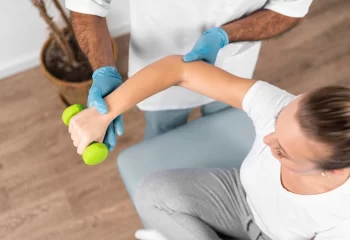The hand is one of the most complex and vital parts of the body. From holding a pen to gripping a weight, your hand provides the strength, precision, and coordination required for everyday function. But any injury to the hand or its surrounding structures—especially the forearm—can greatly affect your quality of life.
At Ace Physio, we offer targeted hand physiotherapy designed to restore movement, reduce pain, and improve the hand’s coordination and strength—while supporting the entire forearm structure that powers it.
Why Hand and Forearm Health Are Inseparable
The hand is one of the most anatomically intricate and functionally important structures in the body. With 27 bones, multiple joints, ligaments, tendons, and a high concentration of nerve endings, the hand allows us to perform delicate tasks with remarkable precision and strength. Whether you’re buttoning a shirt, typing an email, lifting groceries, or performing in a sport, the hand plays a crucial role in daily living.
But hand function doesn’t operate in isolation—it depends significantly on the forearm. Most of the muscles that control your fingers and thumb originate in the forearm, making the two inseparable in both movement and injury recovery. Even a mild injury to the hand or its supporting forearm structures can disrupt your ability to perform basic tasks, impact productivity, and reduce your quality of life.
How We Help at Ace Physio
At Ace Physio, we understand that treating the hand without considering the forearm is an incomplete solution. Our treatment approach combines targeted hand physiotherapy with comprehensive forearm rehabilitation. We address the full kinetic chain—from the fingertips to the elbow—ensuring complete recovery, improved performance, and lasting relief from pain.
We help restore:
-
- Grip strength
-
- Fine motor coordination
-
- Joint mobility and control
-
- Forearm muscle balance
-
- Pain-free daily movement
Whether you’ve experienced trauma, developed a repetitive strain condition, or are recovering from surgery, our team designs personalised treatment plans that consider the full hand–forearm relationship.
Understanding the Hand–Forearm Connection
The muscles that allow your fingers and thumb to flex, extend, grip, and rotate originate in the forearm. These muscles travel down the forearm and connect to tendons that cross the wrist and insert into your hand. As such, any issue affecting the forearm—from overuse to nerve entrapment—can directly impair hand function.
Common issues like carpal tunnel syndrome, trigger finger, or even referred pain from the forearm can limit how your hand moves and feels. That’s why we don’t just treat isolated symptoms—we treat the source.
At Ace Physio, we focus on:
-
- Reducing forearm tension and overuse strain
-
- Restoring nerve mobility and circulation
-
- Rebuilding forearm strength to support hand performance
-
- Improving the neuromuscular control between the forearm and hand
This integrated approach prevents recurrence and promotes full functional recovery.
Common Hand and Forearm Conditions We Treat
Our physiotherapists are experienced in treating a wide range of complex hand and forearm conditions, including:
-
- Dislocated finger – often involving forearm instability or trauma
-
- Ligament injuries in the fingers – affecting grip and alignment, often linked to forearm control
-
- Osteoarthritis of the hand – managing pain, stiffness, and associated forearm compensation
-
- Dupuytren’s contracture – impacting palm and finger flexibility
-
- Broken finger or thumb fractures – requiring strength rebuilding from the forearm down
-
- Fracture of the hook of hamate – a complex wrist-hand injury often misdiagnosed
-
- Metacarpal fracture recovery – including swelling management and forearm reactivation
-
- Tendon and nerve injuries – such as flexor tendon damage or radial/ulnar nerve compression in the forearm
-
- Trigger finger – involving inflammation of tendon sheaths, influenced by forearm overuse
-
- Hyperextension injuries – usually involving the hand’s hinge joints and surrounding forearm stabilizers
-
- Crush injuries – complex trauma affecting both hand and forearm structures
-
- Referred pain from the neck or forearm – causing symptoms in the hand not originating there
Each condition can significantly impair:
-
- Dexterity and finger mobility
-
- Sensation and nerve responsiveness
-
- Grip strength and control
-
- Comfort and pain-free use of your hand
Often, the forearm is not just involved—it is part of the problem. That’s why our therapy always includes forearm-focused interventions to fully resolve the issue.
Symptoms That May Need Hand Physiotherapy
If you experience any of the following, professional physiotherapy may be needed:
-
- Pain or stiffness in your fingers, hand, or forearm
-
- Numbness or tingling radiating from the forearm into the hand
-
- Difficulty gripping or holding objects
-
- Reduced finger coordination
-
- Swelling, deformity, or clicking in the hand or forearm
Our Hand Physiotherapy Approach
We tailor every treatment plan to your diagnosis and goals. Our method focuses on restoring complete upper limb function—starting from the hand and extending through the forearm.
Assessment & Diagnosis
We begin with a thorough evaluation of hand movement, grip strength, and forearm function, often using tools like a goniometer to assess range of motion.
Manual Therapy
Hands-on mobilisation techniques improve joint flexibility, reduce scar tissue, and ease tension in both the hand and forearm.
Strengthening & Control
Custom exercises help rebuild strength in the forearm and stability in the hand, allowing you to regain precision and endurance.
Tendon & Nerve Rehabilitation
For injuries involving tendons or nerves, we focus on safe glide exercises, desensitisation therapy, and forearm nerve mobility.
Functional Training
We replicate real-life hand tasks—such as writing, gripping, or typing—while addressing underlying forearm support and movement patterns.
Why Addressing the Forearm is Essential
Ignoring forearm tension or weakness can lead to incomplete healing, limited mobility, or recurring hand pain. Many hand conditions are caused by or worsened through forearm overuse, poor posture, or repetitive activities. Our therapy always considers the role of the forearm to provide long-term relief and full recovery.
Post-Surgical Hand & Forearm Rehab
After surgery for hand fractures, tendon repairs, or nerve decompression, guided rehabilitation is essential. We help patients recover strength, sensation, and confidence through structured hand and forearm recovery programs—customised to your healing timeline.
Book Your Hand Physiotherapy Appointment Today
Hand pain shouldn’t stop you from doing what you love—whether it’s working, writing, or training. Our physiotherapy combines expert care for both the hand and forearm, ensuring complete recovery and lasting results.
Ace Physio is here to help you heal with precision and purpose—so you can get back to full strength, one movement at a time.
FAQs
A hand physiotherapist assesses and treats injuries or conditions affecting the hand, wrist, and forearm using manual therapy, exercise, splinting, and rehabilitation techniques to restore function, reduce pain, and improve mobility.
Yes, physical therapy for the hand includes targeted treatments like stretching, strengthening, manual therapy, and nerve or tendon rehabilitation to address injuries, post-surgical recovery, or repetitive strain.
Hand therapy is recommended for anyone recovering from hand, wrist, or forearm injuries, surgeries, fractures, arthritis, nerve compression, or overuse conditions that affect hand function and daily activities.
Hand therapy is a specialized branch of physical or occupational therapy focused specifically on the upper limb—from the hand to the forearm and elbow—while general physical therapy can address a broader range of musculoskeletal and neurological conditions throughout the body.










